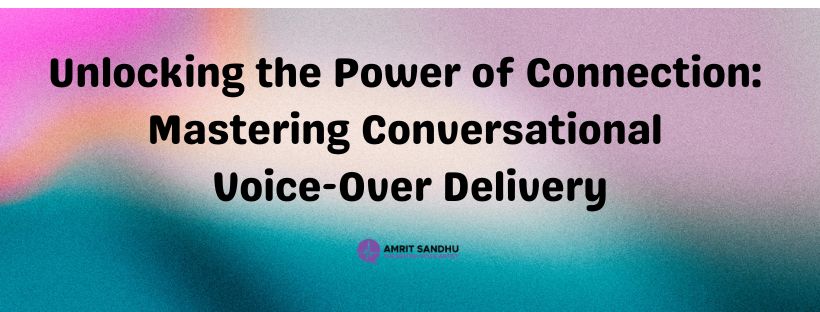In the world of voice-overs, technical proficiency is essential. Crystal-clear audio, precise pronunciation, and a commanding tone are all vital. But what truly elevates a voice-over from good to great? What transforms a simple narration into an engaging, memorable experience? The answer lies in mastering conversational delivery.
This isn’t about abandoning professionalism; it’s about infusing your work with a natural, relatable quality that resonates deeply with listeners. It’s about making the audience feel like you’re speaking directly to them, sharing a story, not simply reciting information. This blog post will delve into the art of conversational delivery, exploring what makes it unique and providing practical techniques to help you hone this crucial skill.
Beyond the Read: The Essence of Conversational Delivery
Think about your everyday conversations. They’re rarely perfectly structured, grammatically flawless monologues. Instead, they’re a dynamic interplay of pauses, inflections, rhythms, and spontaneous expressions. This natural flow, this inherent humanness, is what we strive to capture in conversational voice-over work.
Unlike traditional, more formal voice-over styles, conversational delivery aims to create a sense of intimacy and connection. It’s about sounding authentic, genuine, and relatable—like you’re having a conversation with the listener, not simply reciting words from a script. This subtle shift in approach dramatically alters the listener’s experience, fostering a deeper engagement and more impactful message.
The key difference isn’t about sacrificing professionalism; it’s about adding a layer of humanity and warmth. It’s the difference between someone reading a script and someone sharing a story. This subtle yet profound distinction is what sets conversational delivery apart and makes it so highly sought after by clients across various industries, from e-learning and advertising to audiobooks and podcasts.
Key Techniques for Mastering the Art of Conversational Delivery
Mastering conversational delivery requires practice, patience, and a keen ear. It’s about understanding the subtle nuances of human speech and translating them into your voice-over work. Here are some key techniques to help you on your journey:
1. Embrace the Power of the Pause:
Pauses are not mere filler; they are vital tools for creating emphasis, allowing the listener time to process information, and building dramatic tension. They’re the breath between phrases, the punctuation in natural speech. Don’t be afraid of silence! Strategic pauses can transform a flat delivery into a dynamic, engaging experience. Experiment with different lengths of pauses, placing them before key phrases or at the end of sentences to enhance impact. Listen to your favorite podcasters or audiobook narrators; notice how they use pauses to control pace and create emotional impact.
2. Inflection: Your Voice’s Secret Weapon:
Monotone is the death knell of conversational delivery. Vary your pitch and tone to reflect the emotion and meaning of the words. Inflection is what adds color and life to your voice, making it expressive and engaging. Think of it as the music of your speech. Practice modulating your pitch to convey different emotions—excitement, curiosity, concern—to add layers of meaning to your delivery. Record yourself and listen back critically, paying close attention to your inflection patterns. Are they varied and natural, or flat and monotonous?
3. Read Aloud, Naturally: The Power of Rehearsal:
Before hitting the record button, practice reading the script aloud multiple times. Don’t just read the words; speak them. Imagine you’re chatting with a friend about the subject matter. This informal approach helps you to discover the natural rhythm and phrasing of the script, eliminating robotic delivery. Practice in front of a mirror to observe your body language and facial expressions; they often influence your vocal delivery. This immersive rehearsal process helps you internalize the script, allowing for a more spontaneous and natural performance.
4. Know Your Script Inside and Out: Understanding is Key:
Thorough understanding of the script is paramount. The more comfortable you are with the content, the more natural your delivery will sound. Don’t just read the words; understand the context, the underlying message, and the intended emotion. If necessary, research the topic to gain a deeper understanding. The more confident and knowledgeable you are, the more relaxed and natural your performance will be. This confidence translates into a more engaging and believable delivery.
5. Listen Back Critically: The Art of Self-Assessment:
Record yourself and listen back objectively. This is crucial for identifying areas where you can improve your pacing, inflection, and overall naturalness. Be honest with yourself; don’t shy away from pointing out flaws. Pay attention to your pacing—are there any awkward pauses or rushed sections? Are your inflections varied and natural, or monotonous? Do you sound genuinely engaged with the material, or are you simply reciting words? This self-assessment process is essential for continuous improvement.
6. Practice, Practice, Practice: The Path to Mastery:
Mastering conversational delivery requires consistent practice. Record yourself regularly, focusing on refining your technique. Experiment with different scripts and styles to expand your range and comfort level. Don’t be afraid to try new things and push your boundaries. The more you practice, the more natural and effortless your conversational delivery will become. Consider recording yourself reading excerpts from books or articles. This provides excellent practice in finding the natural rhythm and flow of language.
Beyond the Basics: Elevating Your Conversational Delivery
While mastering the fundamental techniques outlined above is crucial, several advanced strategies can further elevate your conversational voice-over skills:
– Understanding Your Audience: Who are you speaking to? Tailoring your delivery to resonate with your target audience is essential. Consider their age, background, and interests. A conversational delivery for children will differ significantly from one aimed at professionals. Researching your target audience beforehand can significantly improve your performance.
– Microphone Mastery: Different microphones can impact the sound of your voice. Experiment to find a microphone that captures your natural tone effectively. A good microphone can significantly improve the quality of your recordings, making your voice sound clearer and more natural.
– Environment Matters: Background noise is the enemy of a natural sound. Ensure your recording environment is as quiet as possible. Invest in soundproofing materials if necessary. A clean, uncluttered audio track allows your voice to shine through.
– Emotional Intelligence: Conversational delivery is not just about words; it’s about emotion. Connect with the script’s message on an emotional level and let that emotion guide your performance. Consider the mood, tone, and overall message of the script and adjust your delivery accordingly.
– Character Development (for narrative work): If you’re working on a narrative piece, consider the character you’re portraying. Give that character a personality, background, and distinct vocal traits. This helps to create a more believable and engaging performance.
– Post-Production Polish: While conversational delivery aims for naturalness, some post-production editing is often necessary to remove minor imperfections or to fine-tune the audio. However, avoid over-editing, which can strip away the natural flow and spontaneity of your performance.
Conclusion: The Journey to Conversational Mastery
Mastering conversational voice-over delivery is a journey, not a destination. It requires dedication, consistent practice, and a willingness to experiment. By embracing the techniques discussed in this post and continuously refining your skills, you can transform your voice-over work, creating a more engaging, memorable, and impactful experience for your listeners. The reward? A deeper connection with your audience and a significant boost to your professional success.




